| |
|
GUEST COLUMN
KLS: A rare syndrome affecting Ashkenazi families for which there is no known cure
By Gaylene Fisch
SOLANA BEACH, California—Most of us have heard of Tay Sachs and Gaucher’s disease – disorders with genetic components that are more common in Jewish populations than….. There is another disease that seems to be more prevalent in Ashkenazi Jews and is the focus of new research. It is called Kleine-Levin Syndrome, or KLS and it strikes adolescents with males affected four times more than girls. The disorder is characterized by periods of excessive sleep and altered behavior that can last several weeks to months and may occur on and off for years. When it strikes without warning most patients are bedridden and unable to attend school, work or even care for themselves.
During a KLS episode the patient becomes very drowsy, sleeping most of the day and night waking only to eat and go to the bathroom. When awake the patient’s whole demeanor is changed often appearing “spacey” or childlike. Some report confusion, disorientation and hallucinations and an episode usually lasts about 10 to 14 days. Affected individuals may go for a period of weeks, months or even years without experiencing any symptoms and in between episodes they are in perfect health with no evidence of behavioral or physical dysfunction. Currently there is no treatment or cure for KLS. The only news that offers some sense of comfort is that most patients outgrow the disorder by their mid -twenties.
We had never heard of KLS when our 14 year old son became ill last April and was hospitalized with this bizarre set of symptoms. The doctors at Children’s hospital ran a battery of test; CAT scans, MRI’s, EEG’s, neuro exams, lumbar puncture, just to name a few. All were negative and still the team had no idea what was wrong. Without a concrete diagnosis the doctors decided to treat him as a psychiatric patient and they recommended heavy medications and mental health treatment. While pondering this course and after 2 weeks of altered mental status and profound drowsiness he spontaneously returned to normal which really baffled the team of physicians on his case. They attributed his illness to an unknown viral infection of the brain and told us to be happy that we had our son back. He had little recollection of what had transpired during his illness.
Two weeks later he became ill again with the same symptoms but this time we did our own research instead of heading to the hospital. A simple internet search yielded several dozen hits on the topic of KLS and the symptoms were identical to what our son was living through and what we were observing. Within hours we were talking with researchers at Stanford University who are currently studying KLS and learned that kids who have both parents from Ashkenazi heritage are 15 times more likely to develop the disorder.
To date our son has had three episodes which makes us newcomers to the KLS world. We have given our blood samples to the researchers at Stanford so that we can be included in the study now in progress and we are communicating with other KLS patients and families to gather support.
Varda and Neal Farber in Boston along with the Maier family and other board members are the driving force behind the KLS Foundation and the international campaign to raise awareness and funds for research. They have traveled to Israel where there are clusters of cases due to the suspected but as yet unproven genetic predisposition for the disorder, to speak with and support researchers.
While there is no treatment or cure for KLS, knowledge is power. The average time from the first KLS episode to diagnosis is 4 years and this is perhaps the most tragic part of KLS. There are probably kids out there with psychiatric diagnoses that are being treated with medication and hospitalization who may actually have KLS and the only way to help those individuals and families is through increased awareness. Understanding what our son is going through we are better equipped to support him during his illness and we are able to rest assured that in time he will return to us and to life as usual- and eventually outgrow the disorder completely.
It would be great if sharing his story would help even one other family out there to recognize the symptoms and seek help rather than accepting an incorrect diagnosis that could be devastating if not life-altering. And so we share our story with the hope that raising awareness will lead to expeditious diagnoses for other KLS patients and also inspire fundraising that will support research to find a cause and a cure for Kleine-Levin Syndrome.
For more information please visit the National KLS Foundation website at www.klsfoundation.org
Fisch is president of Advantage Medical Devices, a division of Medco International Inc. This article initially appeared in Pathfinder, the monthly newsletter of Temple Solel in Cardiff-by-the-Sea, where the Fisch family are members.


THE JEWISH CITIZEN
Strolling through the knotty questions of inter-religious and inter-Jewish relations
By Donald H. Harrison
 SAN DIEGO—One of the pleasures of my life are walks through various section of Mission Trails Regional Park. Sometimes I like to go around the Padre Dam area; other times around Lake Murray. I’ll confess I don’t go up Cowles Mountain anymore; I don’t have the wind for it. SAN DIEGO—One of the pleasures of my life are walks through various section of Mission Trails Regional Park. Sometimes I like to go around the Padre Dam area; other times around Lake Murray. I’ll confess I don’t go up Cowles Mountain anymore; I don’t have the wind for it.
Besides for the scenery, which is an ever-changing tableau of flora, migratory birds, and small mammals, and for the exercise, which every doctor I know either professionally or socially cautions me is very important, I treasure
Donald H. Harrison
these walks for the companionship and the discussions that I have along the trails and pathways.

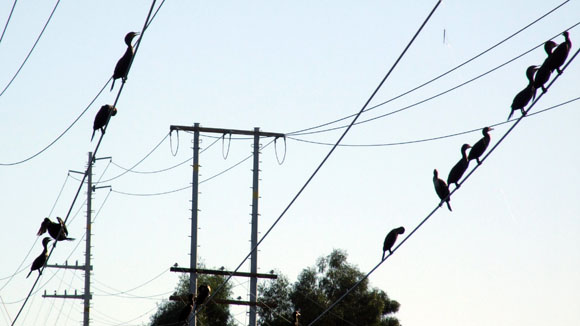
Top: Old Padre Dam; Bottom: Migratory birds find rest above Lake Murray
Not all the friends I walk with are Jewish, but, among those who are, there seems to be a wide spectrum of opinion on perennial Jewish topics. None of my friends is a crazy left-winger or an extremist right-winger; nevertheless, that still leaves a lot of room for disagreement.
I must say that part of the charm of walking with them is that we disagree agreeably. Some of my friends think I am far too liberal on questions facing Israel; others think that I am way too hide-bound and conservative. I guess that makes me a moderate.
I wish that I could walk with each reader of San Diego Jewish World to hear your ideas and to test out mine, but, as that is impossible, I thought I’d share with you thoughts on two topics that have come up recently on walks: 1) The relationships of Jews with Muslims, and 2) the relationship between Jews of the United States and those of Israel.
My contention is that the people among us who point to every hate sermon by Islamic preachers as proof that Muslims’ principal mission in life is to kill Jews or to destroy Israel do both the Muslims and us Jews a disservice.
Yes, there are fiery preachers who call upon the trees and the rocks to point out Jews who might be hiding behind them, so that the Jews can be killed; there are textbooks in the Muslim world comparing Jews to apes, and there are cartoon shows that dehumanize us Jews in the same way that Nazi caricatures of Jews attempted to condition the European populace to welcome our destruction.
We have enemies out there, no question about it.
However, there are also potential friends in the Muslim world, which is as diverse and perhaps more divided internally than even we Jews are. The battles between our Orthodox and Reform movements are nothing compared to the violence between Sunni and Shi’ite. The Muslim leadership of Turkey, which has a longstanding friendship with Israel, needs to be differentiated from the Muslim leaders of Syria or Iran. The leaders of Egypt, Jordan, Morocco and the Gulf States seem far more interested in dealing with internal affairs than in inciting hatred against Jews and Israel, although some habits apparently die hard.
In East Asia, particularly in Indonesia, where people have the perspective of not living so close to the Arab-Israeli conflict, there are some signs that Muslims there are increasingly willing to live in peace with Jews.
In the United States, second- and third-generation Muslims probably have more in common with us Jews, given our mutual love for American democratic institutions, than they have with some of their co-religionists in the Middle East.
So what does this all mean? We need to resist the temptation to lump all Muslims together. We need to judge individuals, and countries, by their actions, and not by what the firebrands among them have to say. We must offer and be ready to grasp the hand of friendship whenever it is possible.
As for the relationship between the Jews of Israel and the Jews of the United States, I believe that we are mutually dependent upon each other. I reject the notion of some Zionists that all Jews ought to make aliyah to Israel, and that anyone who doesn’t somehow has abandoned his or her heritage.
Just as our heredity is determined by both our father and our mother, so too are our identities determined by both our religion and our nation. If Judaism is my mother, then Americanism is my father. I love both these parents. I belong in my wonderful native country, the United States, which I so love and admire. At the same time, I feel a sense of duty to my fellow Jews, wherever in the world they may live, because they are part of my extended family.
If they are being oppressed in Europe, Africa, Asia, South America, or anywhere else in the world, I want to help them get to safety. If Israel is being bullied, I want to help it defend itself. And if Iran, Al-Queda, Syria, Hamas, Hezbollah and the other enemies ever were to be successful, God forbid, in eliminating Israel from the map, I would want to be among those advocating that the United States accept Israeli Jews en masse as refugees.
Similarly, and may this danger also perish, if the forces of repression and religious intolerance ever were to gain the ascendancy in the United States, I am glad that there are family members in Israel who would be willing to take me and my family in.
American Jewry and Israeli Jewry—we are each other’s insurance policies that even if the world goes crazy, we will not be abandoned.
When my Israeli friends and relatives tell me to make aliyah, I tell them that in Israel, I would be a burden. I don’t speak Hebrew. I’m past the age of starting and building a career. I am not a wealthy philanthropist, who can finance great projects in Israel.
Chances are, as I got older, I would be another jobless person that the State of Israel would have to support. Here, in the United States, I speak the language, can support myself, and have friends and contacts to whom I can try to communicate the many commonalities between Israel and the United States, between Jews and Christians, and between my spiritual mother and father.
I can hardly wait to go on my next walk.
< BACK TO TOP

Scholars-in-residence
program
Presentations are free; kosher meals moderately priced
● Rabbi
Motti Berger, founder of "Jews for Judaism," Nov. 16-17
● Rabbi
Yakov Horowitz, founder, Project Y.E.S. (Youth Enrichment Services)
for
Agudath Israel, Jan. 4-5
● Rabbi Ari
Kahn, director, Foreign Student Programs,
Bar Ilan University, Israel, Feb.
22-23
Call us for details at (619)
287-9890
|
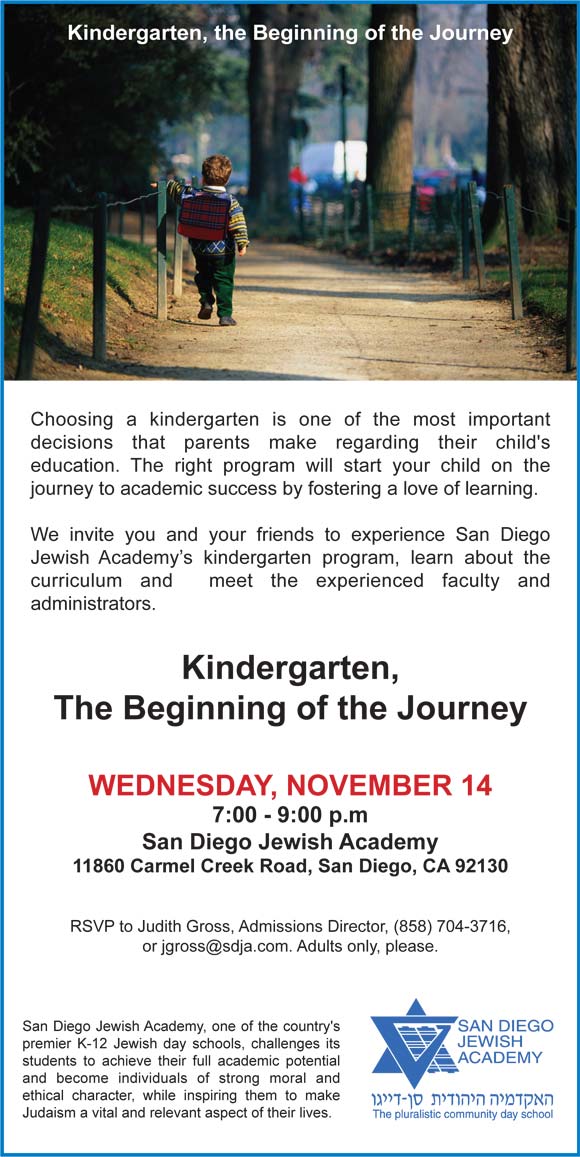

Baptist minister shares 35 years of Israeli memories with Women's Ort lunch group
By Gerry Greber
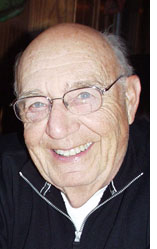 SOLANA BEACH, California—In 1955 the Reverend James E. Smith, a Baptist minister, felt a calling that his physical presence was needed in the land of Israel. A colleague who was living in Israel at that time wrote to him about the “needs” and the current happenings there. SOLANA BEACH, California—In 1955 the Reverend James E. Smith, a Baptist minister, felt a calling that his physical presence was needed in the land of Israel. A colleague who was living in Israel at that time wrote to him about the “needs” and the current happenings there.
Smith, who held a pulpit at a church in Georgia, answered the “call” taking his wife, Elizabeth, and 13 month old daughter, Jackie, to the Holy Land.
He and his wife were guest speakers a week ago at a Women’s American ORT chapter luncheon meeting at the Lomas Santa Fe Country Club where they discussed their 35-year Israeli experience.
During his time there he lived in many different cities and had different
Gerry Greber
experiences in each location. After ministering in Nazareth, where hiscongregation was predominantly Arab, he moved to Ashkelon and eventually to Jerusalem where his congregants were a diverse group. In Jerusalem it consisted of European internationals, Arabs, and Israelis.
He also had a diverse group in Ashkelon. There he worked with a conservative Rabbi Phil Spector, and together they invited Arab friends in Gaza to meet their Jewish neighbors. The Arabs wanted to learn Hebrew, and the Israelis wanted to learn Arabic. He started a group called Ha Yachad which he said was an Essene name for their community.
“The group got together to discuss poetry, music, literature, favorite religious holidays, Jewish, Muslim, and Christian,” Smith said. “We tried to stay away from anything that involved conflict and controversy.” “Everything was going along beautifully” he continued. “Unfortunately, the intifada put an end to everything.”
Subsequently, the Jewish congregation built a new synagogue and the names of Smith and his wife Betty were included on the scroll that was enclosed in the cornerstone.
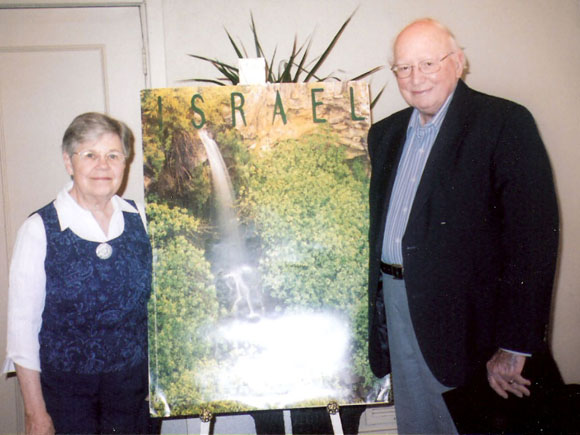
Betty and the Rev. James Smith, longtime Israel residents
Smith furthered his Jewish education while living in Ashkelon. It was here that he “bought” Rabbi Spector’s chumatz by completing the tying of a knot that Rabbi Spector brought over before Passover. After the holiday, Rabbi Spector “bought” it back by untying the knot.
Smith was in the vicinity of several hand grenade attacks while traveling between Ashkelon and Gaza. A colleague of his was killed during a terrorist attack while in Gaza.
Later he moved with his family to Jerusalem. There he joined an interfaith group that put him in contact with some professors from Hebrew University as well as members of different religious faiths. This committee sponsored a number of meetings targeted toward peace and harmony. They elected a Muslim president and the Reverend Smith became Vice-President.
While living in Jerusalem, he learned something more about Judaism by becoming well known as the “Shabbos goy.” One Friday night there was a banging on the front door. When he answered it, he saw a man with a big fur hat, long paios, with his tzi tzis showing-that is, “the complete regalia.” The person told him the fire in his stove had gone out and that “they would not be able to have a hot meal all of Shabbat.” He naturally went with him to relight his stove. This type of thing recurred frequently and he found himself resetting thermostats, rewinding a watch and so forth.
Not all his memories about Israel were upbeat. Living in Jerusalem was not without conflict. The Baptist church in Jerusalem is bordered by Rahavia, a haredi community. There was mixed feelings about the Baptists being in that area. In 1982, “some extremists, with connections to Meir Kahane,” according to Reverend Smith, “went and torched the Baptist church and burned it to the ground. It took about 12 years dealing with all the Orthodox religious parties in the government, a coalition of 26 political parties at that time, to rebuild the church.” He also stated that recently he heard that there was another attack on the church. “This time it survived although damaged.”
As Christians they received special permission to cross what was once the Jordanian border at Easter time to go to Bethlehem. In addition they went to the top of the Mount Nebo where Moses watched the Hebrews enter “The Promised Land” without him.
At one point, he reflected on “how the Jews managed to survive.” He marveled at Jewish history which involved “dealing with the Canaanites, the Egyptians, the Assyrians, the Babylonians, the Persians, the Greeks, the Romans, the Crusaders, the Ottoman Empire, the British Mandate, and finally in 1948 the State of Israel was formed. He suggested that Israel “was still at the crossroads of the world."
After Reverend Smith spoke, his wife Elizabeth (Betty) spoke about some of the interesting biblical sights they saw and visited while living in Israel. She brought several large poster maps of Israel and identified several places that are mentioned in the Bible. One of them was Ein Gedi where she said that David and his men found a well with fresh water and were eventually saved. She particularly recommended visiting Nazareth and seeing the new construction, built on a hillside, for the Jewish community that replicated the ancient life and times of Israel.
She also mentioned that their daughter, Jackie Winter, a professor of World Religions at Palomar College, is currently instructing the Marines at Camp Pendleton prior to their tours of duty in the Middle East.
During the question period after their formal presentation, Smith was asked his opinion of a fellow Baptist, former U.S. President Jimmy Carter and his book Palestine: Peace Not Apartheid. He stated “I had a better opinion of him before he wrote his book than I have now.”
Currently, the Smiths are living in Oceanside. He is a consultant to various church groups in that area.
< BACK TO TOP


A HERALD IN ZION
The quieter voices at Israel's playground
By Dorothea Shefer-Vanson
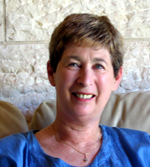 EILAT, Israel—In the middle of the cold Jerusalem winter we like to spend some days in Eilat, enjoying the sun and the pool while the rest of the country is shivering. We take our children and grandchildren along for a full-board weekend so that no-one can complain of being hungry. EILAT, Israel—In the middle of the cold Jerusalem winter we like to spend some days in Eilat, enjoying the sun and the pool while the rest of the country is shivering. We take our children and grandchildren along for a full-board weekend so that no-one can complain of being hungry.
But the last time there were ominous signs as we checked in. Tour buses rolled up and parked outside the entrance, discharging hordes of people. There were couples with children and grandparents in tow, fathers wheeling suitcases, mothers schlepping packages and toddlers clutching toys. In a way
Dorothea Shefer-Vanson
they were quite like us. But there was one big difference. They were all talking Russian.
Then we noticed the sign in the lobby welcoming the employees of a large Israeli manufacturing plant. We sighed resignedly, One can’t expect a hotel in Eilat to be half-empty at the weekend, even if it is not high season. However, Israelis en masse can be rather noisy, and even rowdy, and we were worried that our weekend would be spoiled.
But our fears were soon allayed. The Russian language was spoken, not shouted. Most of the people we encountered, whether beside the pool, in the dining room or in the lobby, were polite and well-behaved. The children were not rowdier than ours, and one hardly felt that the work-force of a rather large factory, together with the management, had taken over the hotel.
The hotel staff rallied manfully to meet the challenge. They tried to keep smiling and were invariably helpful. Some of them even spoke Russian. It is an undisputable fact that the influx of Russian immigrants has contributed to Israel’s cultural life and industrial success. Perhaps the Russian immigration may even serve to temper Israelis’ loud voices. Maybe soon Hebrew will be spoken not shouted.
< BACK TO TOP


THE JEWS DOWN UNDER
Former Labor prime minister slams Liberals' pot shot about Israel
By Garry Fabian
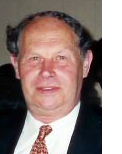 CANBERRA—Former Prime Minister Bob Hawke has lashed out at the Howard Government accusing the treasurer of saying "despicable things" about the Labor Party's support for Israel and of mismanaging its huge budget surplus. CANBERRA—Former Prime Minister Bob Hawke has lashed out at the Howard Government accusing the treasurer of saying "despicable things" about the Labor Party's support for Israel and of mismanaging its huge budget surplus.
Hawke, Australia's prime minister between 1983 and 1991, visited Israel a number of times and was seen as a great friend of the Jewish State and the local community.
Hawke criticised comments made by Treasurer Peter Costello in September that the
Garry Fabian
ALP's support for Israel would wane if it won government because of pressure from the party's left elements and trade unions.
Hawke, a former union boss himself, responded: "The Liberal leadership - John Howard and Costello - said many despicable things during the course of the campaign and untruthful things. We're used to that, of course, but I find this particularly offensive."
"I don't think I need to speak about my record on Israel," he continued. "Kevin Rudd has visited Israel twice, he is absolutely committed to the survival and integrity of Israel behind secure and recognised boundaries.
"This is a pathetic, low-class accusation from desperate men."
The 78-year-old said that he has travelled across the country during the campaign, making sure that voters see Rudd as the correct option for prime minister.
"I am very happy to campaign for Kevin Rudd this time ... and I'll campaign again so that he will break my record as the longest-serving Labor prime minister, I'm quite happy to see that happen," he said.
Stark memories of Kristallnacht
SYDNEY—A capacity crowd attended the commemoration service for the 69th anniversary of Kristallnacht , the night of broken glass, at the Sydney Jewish Museum on Sunday night.
The evening was remembered on an intimate level by World War II survivor Gertie Jellinek.
And later the audience saw an intriguing interview with author Thomas Keneally and a partial re-enactment of his latest play, Either Or.
The predominantly older crowd recited kaddish and listened soberly to Jellinek, a volunteer at the museum, as she told how she was a 12-year-old girl living in Austria when German soldiers entered her family's apartment on Kristallnacht and took her father away for 10 days.
Her family had no idea of his welfare or whereabouts.
The evening was co-hosted by the NSW Jewish Board of Deputies, the Sydney Jewish Museum and the Australian Association of Jewish Holocaust Survivors & Descendants.
The interview with Keneally, which illuminated the horrors of the time, was conducted by ABC journalist Dr Rachel Kohn.
Keneally, the well-known author of Schindler's Ark, a book that was later adapted by Steven Spielberg into the Oscar-winning movie Schindler's List, took another anti-hero as the centre of the story.
< BACK TO TOP


JEWISH CONNECTIONS IN DANCE
Tango's repetitive dance moves and lack
of color in costuming can tire audiences
By Sheila Orysiek
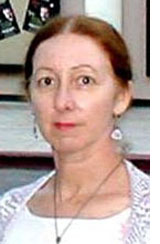 COSTA MESA, California—Tango is the child of Argentina, much as Blues was born in America. We are used to thinking of tango as a dance, but it is much more than that; a distinct rhythm, a genre of music as well as a slice of life. It is also the offspring of several genealogies: Spanish, Sephardic, Arabic, and African; Gaucho as well as urban. COSTA MESA, California—Tango is the child of Argentina, much as Blues was born in America. We are used to thinking of tango as a dance, but it is much more than that; a distinct rhythm, a genre of music as well as a slice of life. It is also the offspring of several genealogies: Spanish, Sephardic, Arabic, and African; Gaucho as well as urban.
When the main body of Jewish immigration to Argentina occurred in 1890, tango was already established. Jewish contribution has been mostly in the music; both composition and execution with several virtuoso instrumentalists as well as lyricists. Some of it has been adapted to an almost Klezmer sound to satisfy the Jewish community of Argentina.
Tango Buenos Aires was presented at the Orange County Performing Arts Center here on November 10 as part of the dance series season for 2007-2008. It is important for me to say that I don’t consider myself technically knowledgeable in the structure of this particular dance form. Some critics who are knowledgeable in one area of the performing arts feel that gives a license to critique other areas; thus a music critic is sent out to critique dance or opera, etcetera. If such an attempt is made, the reader should be so informed. For that reason I will concentrate for the most part upon production values rather than the technical elements inherent to tango.
Some genres of dance are highly structured such as ballet and performances are judged on many levels: technical accomplishment, artistic sense, style, characterization, production values, and adherence to the original intent of the choreographer and composer, designs of set, costume, and lighting as well as all over stage direction. Therefore the reviewer must be able to call upon specific expertise as well as have the ability to communicate that opinion - it is not enough to simply write engagingly.
Flamenco, though a dance form I really enjoy, I would never attempt to critique since it is highly structured, with complicated rhythms - not within my ability about which to honestly write an informed opinion. Modern dance, however, prides itself on being unstructured and therefore a candidate for subjective critique. Tango, I suspect is somewhere in between.
The problems with the performance I witnessed are not with the dancers, but mostly with the production values. The dancers are eager, able and committed. I sense a lack of broadness in the choices available within the tango vocabulary. In short order it becomes repetitive. This was amplified by the unremitting use of black in the costuming. Dark stage, black backdrop, dim lighting much of the time - and black, black, black for the men most of the time, and too often for the women too; black shoes, shirts, pants, hats, gloves, dresses, tights and stockings.
Yes, I know black is supposed to be the color of romance, mystery, strength, chic, masculinity, and slinky women - but who cares if one can’t see the movement sufficiently and eventually the eyes stop wanting to look? The women are almost always in short dresses with high slits and the men almost always in total black long/short/medium sleeve shirts, jackets, hats, pants and shoes. Why such fear of color? There was a bit of white, an occasional slash of red, but it was certainly the exception. Dressing a man in grey, tan, blue, even white - does not subtract from the testosterone quotient.
The program notes took up three columns detailing a story synopsis - space that could have been given over to something else: crossword puzzle, cartoon, jokes, and letters to the editor, etc. The story went something like this: Man wants to go out to the local dance hall to meet his friends, plus a woman or two, meets them, then she meets someone else, he gets depressed, tries again, fails, succeeds, fails, everyone dances, the audience applauds, and we all go home. If everyone is in black and the stage is dim how can we keep track of who is dancing with whom?
A story wasn’t necessary and in my opinion points out that the vocabulary range of the dance form doesn’t readily lend itself to story telling. Tango is a dance for two - man/woman - so it’s difficult for one person to tango alone - to tell a story of a single character without slipping into another dance form known as ballet; which happened several times. While well done, that’s not tango. Full out ballet pirouettes, tours en l’air (turns in the air); lifts, etc. interrupt the sweep of tango - which is its glory. When that sweep is interrupted it becomes angular sinuosity; an oxymoron.
Tango is about a horizontal desire expressed vertically - sex and seduction - two people dancing with bodies in constant contact. I don’t see it as being able - or meant to - express other ranges of emotion through the dance itself such as: innocence, repentance, fear, affection, hesitation, or even progression of a relationship other than a seductive one. Therefore, I think using it to attempt a story is like trying to fill a varied landscape with a single topographic feature. Even in seduction - how many times can the woman wrap her leg around the man? How many different emotions can be expressed by staring?
I think for tango to be successful as a full evening’s program - it must get into the music and stay there; make the music visible, let the observer be swept along with the throb and invite the imagination. It is ballroom dance and it certainly is wonderful to watch, but it can’t pretend to be ballet - or anything else - and retain its honesty.
None of this is to take away from the skill of the dancers: it’s just that the dance form - or at least as it was choreographed for this program - doesn’t in my opinion support a full evening of dance. The production values as detailed above don’t help either the dancers or the presentation. Only on two occasions in the series of solos, duos, trios, foursomes, and ensemble - did the dance catch fire. Both times it was when a man and woman danced together - the two bodies become one - to tango music everyone recognizes as tango - and at least for her - colorfully dressed.
The best part of the evening was the five piece band: violin, bass, piano, bandoneon, and guitar - not as far as I could find given credit in the program. They were splendid and the applause they got far surpassed that given for the dancers.
This company is coming to San Diego’s Civic Theatre for one performance only on November 30. Go see them - judge for yourself.
< BACK TO TOP
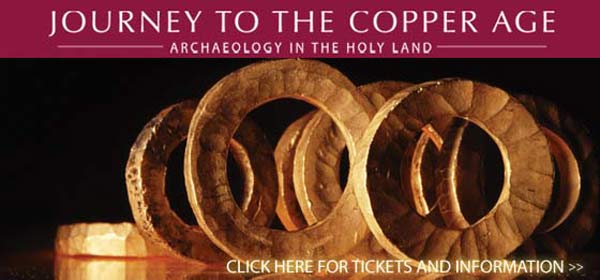

SAN DIEGO JEWISH WORLD
THE WEEK IN REVIEW
TUESDAY, NOVEMBER 13
Shoshana Bryen in Washington, D.C.: Army officer reflects on Veteran's Day about his assignment in the Iraq war
Mitchell Finkel in North Bethesda, Maryland: Why Abbas as peacemaker is unbelievable
Peter Garas in Gordon, Australia: "Colonialism the culprit in Pakistan and elsewhere in unstable world"
Donald H. Harrison in San Diego: Dreams Imagined by Freud Descendant
Michoel Stern in Monsey, New York: What about extending tolerance to the Orthodox members of your family?
Lynne Thrope in San Diego: Culinary stars gather for San Diego Bay Wine and Food Festival
MONDAY, NOVEMBER 12
Shoshana Bryen in Washington, D.C.: Pakistan has neither a racial nor philosophical identity to help unify it.
Natasha Josefowitz in La Jolla, California: We share our territorialism with the lower orders of animal life; can we transcend it?
Joe Naiman in Lakeside, California: Unusual Suspect gladdens a Jewish family
Sheila Orysiek in San Diego: Expanding our view of Veteran's Day
Ira Sharkansy in Jerusalem: 'Right of return' and 'undivided Jerusalem' jeopardize any bargain at Annapolis
SUNDAY, NOVEMBER 11
Sandy Golden in La Jolla, California: "Viorst has kept a generation laughing"
Donald H. Harrison in Encinitas, California: "Hall of History at Seacrest Village recalls the residents of 54th Street Hebrew Home"
Rabbi Baruch Lederman in San Diego: "Why Baruch keeps the kippah on his head"
Joel A. Moskowitz, MD and Arlene Moskowitz, JD in La Jolla, California: "U.S. standing in the world depends upon clear objectives—Dennis Ross"
Rabbi Leonard Rosenthal in San Diego: "Jacob and Esau:Nature over nurture"
Melanie Rubin in San Diego: "San Diego Grandpa and Israeli Native"
Larry Zeiger in San Diego:"Lars finds himself a girl in bizarre movie that will make you laugh—and also think"
Publishers tell changes in format and frequency for San Diego Jewish World
THURSDAY, NOVEMBER 8
Gary Acheatel in Ashland, Oregon: "Carter, Walt, Mearsheimer fail 3-D test in their assessments of Arab-Israeli conflict"
Carol Davis in Vista, California: 'Argentina proves a crackling refuge for European family in The Magic Fire'
Ira Sharkansky in Jerusalem: "U.S. policy-makers have a record of mistakes in U.S.; is Israel next?"
Photo Story: JFS relocates its senior center to Congregation Beth Israel
WEDNESDAY, NOVEMBER 7
Sherry Berlin in La Jolla, California: "Pre-school playground was a wonderful venue for teaching at Jewish Book Fair"
Garry Fabian in Melbourne, Australia: "Australian children enlisted in battle against global warming"... "Another rating system for political candidates: how do their websites compare with each others?" ... "South African rabbi visits Queensland" ... Israeli ambassador's comments may have been 'reason' for vandalism of Jewish cemetery" ... "Same-sex unions attacked by Orthodox rabbi."
Joel A. Moskowitz, MD and Arlene S. Moskowitz, JD in La Jolla, California: "Audience kvells over Tony Kushner"
< BACK TO TOP
|
|

